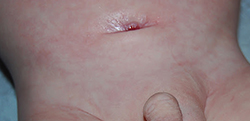 What is a vesicostomy?
What is a vesicostomy?
A vesicostomy is a surgical opening in the bladder to the outside of the body (lower belly) that allows urine to drain, preventing urinary tract infection or damage to the kidneys. A vesicostomy is a temporary treatment.
When is it needed?
Usually infants or children under age 5 years need a vesicostomy for the following reasons:
- The child is born with a condition that results in bladder outlet obstruction. This occurs in conditions such as posterior urethral valves (PUV). A vesicostomy allows the bladder to drain into the diaper. Later, the bladder may be examined with an endoscope, a flexible tube that includes a miniature camera.
- The child has a neurogenic bladder due to a condition such as spina bifida. Special testing, called urodynamics, identifies neurogenic bladders that are at risk to damage the kidneys. In these cases the standard treatment is to place the child on a bladder-relaxing medicine and begin catheterization. These treatments lower pressure in the bladder, which helps in avoiding damage to the kidneys. In cases where this treatment does not safely establish good bladder pressure, a vesicostomy allows temporary drainage of the bladder and protection of the kidneys.
Where is the opening?
The skin opening of the vesicostomy is placed midway between the pubic bone and the umbilicus (belly button). In other words, the opening is under the belly button.
Is any special care needed?
- The vesicostomy will drain freely into the diaper. Diapers are changed no differently than otherwise.
- If a diaper rash occurs around the skin site, then diaper rash ointment or creams may be applied.
Are there any complications?
Complications are unusual for the vesicostomy. Two complications that may occur include:
- Narrowing of the vesicostomy opening that results in poor drainage of the bladder. It is expected that the vesicostomy will narrow during healing and over time after the procedure. The doctor will evaluate drainage, possibly through an ultrasound scan. If the stenosis results in poor drainage, then the doctor may suggest periodic catheterization or dilatation. Additionally, the vesicostomy may need revision of the skin opening and is generally an outpatient procedure.
- Prolapse of bladder tissue through the vesicostomy skin opening. The bladder can sometimes “poke out” (prolapse) through the skin opening. The prolapse occurs during straining, such as when the child cries or has a bowel movement. The prolapse will generally extend an inch or more from the skin site and should be pushed back in when the child is no longer straining.
There is often some local overgrowth of visible, pink bladder mucosa that is at the skin opening of the vesicostomy and should not be confused with bladder prolapse. If bladder prolapse occurs and the prolapse is unable to be pushed back and the child is uncomfortable, please notify your doctor.










